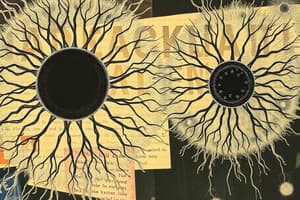Podcast
Questions and Answers
Which statement accurately represents a part of cell theory?
Which statement accurately represents a part of cell theory?
- Cells can arise from non-living matter
- Only plants are made of cells
- All living things are made of cells (correct)
- All cells are multicellular
Eukaryotic cells are generally smaller and simpler than prokaryotic cells.
Eukaryotic cells are generally smaller and simpler than prokaryotic cells.
False (B)
What is the role of the mitochondria in eukaryotic cells?
What is the role of the mitochondria in eukaryotic cells?
Energy production.
Prokaryotic cells do not have a __________ to contain their DNA.
Prokaryotic cells do not have a __________ to contain their DNA.
Match the organelles found in eukaryotic cells with their primary functions:
Match the organelles found in eukaryotic cells with their primary functions:
Which of the following organelles is responsible for the production of ATP during cellular respiration?
Which of the following organelles is responsible for the production of ATP during cellular respiration?
Cell walls are present in both plant and animal cells.
Cell walls are present in both plant and animal cells.
What is activation energy?
What is activation energy?
The organelle that modifies, sorts, and packages macromolecules for transport is the ______.
The organelle that modifies, sorts, and packages macromolecules for transport is the ______.
Match the following organelles with their functions:
Match the following organelles with their functions:
Which structure is responsible for maintaining cell shape and controlling cell motility?
Which structure is responsible for maintaining cell shape and controlling cell motility?
All eukaryotic cells have DNA contained within a nucleus.
All eukaryotic cells have DNA contained within a nucleus.
How do enzymes speed up chemical reactions?
How do enzymes speed up chemical reactions?
In plant cells, the large organelle used for digestion and waste release is called a ______.
In plant cells, the large organelle used for digestion and waste release is called a ______.
Which of the following statements about enzymes is true?
Which of the following statements about enzymes is true?
Flashcards
Cell Theory Parts
Cell Theory Parts
All living things are made of cells, and all cells come from other cells.
Prokaryotic Cell
Prokaryotic Cell
Smaller, simpler cells without a nucleus or membrane-bound organelles, often single-celled (e.g., bacteria).
Eukaryotic Cell
Eukaryotic Cell
Larger, more complex cells with a nucleus and membrane-bound organelles, can be single or multi-celled (e.g., plant, animal cells).
Eukaryotic Organelles
Eukaryotic Organelles
Signup and view all the flashcards
Plant vs. Animal Cells
Plant vs. Animal Cells
Signup and view all the flashcards
Cell Wall
Cell Wall
Signup and view all the flashcards
Chloroplast
Chloroplast
Signup and view all the flashcards
Vacuole (Plant)
Vacuole (Plant)
Signup and view all the flashcards
Ribosomes
Ribosomes
Signup and view all the flashcards
Cell Membrane
Cell Membrane
Signup and view all the flashcards
Nucleus
Nucleus
Signup and view all the flashcards
Cytosol
Cytosol
Signup and view all the flashcards
Enzyme
Enzyme
Signup and view all the flashcards
Study Notes
Cell Theory
- All living things are made of cells.
- All cells come from other cells.
Prokaryotic vs. Eukaryotic Cells
- Prokaryotic:
- DNA not contained within a nucleus.
- Simpler and smaller.
- No membrane-bound organelles.
- Usually single-celled (e.g., bacteria).
- Eukaryotic:
- DNA enclosed within a nucleus.
- Larger and more complex.
- Contains membrane-bound organelles.
- Can be single-celled OR multicellular (e.g., plant and animal cells).
Eukaryotic Organelles and Functions
- Genetic control: Nucleus and ribosomes
- Manufacturing, transport, and digestion: Golgi apparatus, endoplasmic reticulum (ER), lysosomes, peroxisomes, ribosomes
- Energy: Mitochondria and chloroplasts
- Structural support and movement: Cell wall, cytoskeleton, cell membrane
Plant vs. Animal Cells
- Plant cells only: Cell wall, chloroplasts
- Vacuoles: Large in plant cells, small in animal cells.
- All cells contain: Ribosomes, cytosol, cell membrane
Vocabulary
- Cell Theory: Two tenets: all living things are composed of cells, and all cells come from other cells.
- Nucleus: Contains DNA, controls cell activity.
- Nucleolus: Produces ribosomes.
- Cytosol: Fluid outside the nucleus, site of cell metabolism.
- Cytoplasm: Contains cytosol and organelles.
- Centrosome: Produces proteins for cell division (microtubules).
- Golgi apparatus: Modifies, sorts, and packages macromolecules.
- Lysosome: Contains enzymes for intracellular digestion.
- Peroxisome: Contains enzymes for various metabolic reactions.
- Vesicle: Transports materials within the cell.
- Cell membrane: Semipermeable barrier that regulates what enters and leaves the cell.
- Mitochondria: Major ATP producer in cellular respiration.
- Vacuole: Stores water and creates pressure, used for digestion and waste release, larger in plant cells.
- Cell wall: Rigid, protective barrier made of cellulose, present in plant cells.
- Chloroplast: Site of photosynthesis, contains chlorophyll, present in plant cells.
- Smooth ER: Lipid synthesis, breaks down toxins.
- Rough ER: Transports proteins.
- Ribosome: Protein synthesis.
- Cytoskeleton: Maintains cell shape, controls motility.
- Organelles: Specialized structures performing specific tasks in the cell.
Activation Energy and Enzymes
- Activation energy: The energy needed for a chemical reaction to start.
- Enzymes: Lower activation energy, speeding up reactions. They are reusable catalysts.
Enzyme-Substrate Interaction
- Substrate: The molecule the enzyme acts upon.
- Active site: The specific region of the enzyme where the substrate binds.
- Substrate binding causes a slight change in enzyme shape, which promotes catalysis.
Environmental Effects on Enzyme Activity
- Temperature: Enzymes have optimal temperatures and ranges. Higher temperatures can denature them.
- pH: Enzymes have optimal pH ranges. Changes in pH can interfere with enzyme activity (denaturing) by affecting interactions.
Studying That Suits You
Use AI to generate personalized quizzes and flashcards to suit your learning preferences.




